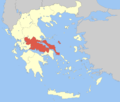Delphi (modern town)
Delphi
Δελφοί | |
|---|---|
UTC+3 (EEST) | |
| Vehicle registration | ΑΜ |
The modern town of Delphi (/ˈdɛlfaɪ/ or /ˈdɛlfi/; Greek: Δελφοί, [ðelˈfi]) is situated immediately west of the archaeological site of the same name. The town was created as a home for the population of Castro, which was relocated to allow for the excavation of the site of ancient Delphi. The importance of the twin locations grew to the point where Delphi has also been made the name of the modern-day municipality, which includes the communities of the Plaistos valley system as far south as the Gulf of Corinth. The name Delphi came from the Oracle of Delphi, which was anciently accepted as a purveyor of truth revealed by the god Apollo.
Town
The twin sites are on Greek National Road 48 linking Amfissa with Livadeia. The town contains extensive facilities supporting the tourist trade at the ancient site. Like the ancient Sacred Precinct, the town preserves a vertical dimension by terracing the streets and buildings. The streets are narrow, and often one-way. The E4 European long distance path passes through the east end of the town. In addition to the archaeological interest, Delphi attracts tourists visiting the Parnassus Ski Center and the popular coastal towns of the region.
History
Occupation of the site at Delphi can be traced back to the Neolithic period with extensive occupation and use beginning in the Mycenaean period (1600–1100 BC).
Ancient Delphi
Earlier myths [2][3] include traditions that Pythia, or the Delphic oracle, already was the site of an important oracle in the pre-classical Greek world (as early as 1400 BC) and, rededicated from about 800 BC, when it served as the major site during classical times for the worship of the god Apollo.

Delphi was since ancient times a place of worship for
In 356 BC the Phocians under Philomelos captured and sacked Delphi, leading to the
Εἴπατε τῷ βασιλεῖ, χαμαὶ πέσε δαίδαλος αὐλά,
οὐκέτι Φοῖβος ἔχει καλύβην, οὐ μάντιδα δάφνην,
οὐ παγὰν λαλέουσαν, ἀπέσβετο καὶ λάλον ὕδωρ.
[Tell the king that the flute has fallen to the ground. Phoebus does not have a home any more, neither an oracular laurel, nor a speaking fountain, because the talking water has dried out.]
It was shut down during the persecution of pagans in the late Roman Empire by Theodosius I in 381 AD.[4]
Amphictyonic Council
The
The sacred precinct in the Iron Age
Excavation at Delphi, which was a post-Mycenaean settlement of the late 9th century, has uncovered artifacts increasing steadily in volume beginning with the last quarter of the 8th century BC. Pottery and bronze as well as tripod dedications continue in a steady stream, in contrast to Olympia. Neither the range of objects nor the presence of prestigious dedications proves that Delphi was a focus of attention for a wide range of worshippers, but the large quantity of valuable goods, found in no other mainland sanctuary, encourages that view.
These Pythian Games rank second among the four stephantic games chronologically and in importance.[5] These games, though, were different from the games at Olympia in that they were not of such vast importance to the city of Delphi as the games at Olympia were to the area surrounding Olympia. Delphi would have been a renowned city regardless of whether it hosted these games; it had other attractions that led to it being labeled the "omphalos" (navel) of the earth, in other words, the centre of the world.[5][7]
In the inner hestia (
Abandonment and rediscovery
The
Ottoman period and Middle Ages
Municipality
The municipality Delphi was formed at the 2011 local government reform by the merger of the following 8 former municipalities, that became municipal units:[10]
The municipality has an area of 1121.671 km2, the municipal unit 73.126 km2.[11] The administrative seat of the municipality is in the largest town, Amfissa. The total population of the municipality is 32,263. The town Delphi has a population of 2,373 people while the population of the municipal unit of Delphi, including Chrisso (ancient Krissa), is 3,511.[10]
See also
- Ancient Delphi
- Franz Weber (activist) - made an honorary citizen of Delphi in 1997
- List of traditional Greek place names
Gallery
-
House of Angelos Sikelianos
-
Saint Nicolas church
-
Town hall
-
Building and view into valley
-
Valley and road sign
-
Entrance flags
-
Fence and valley
-
Olive trees and water aqueduct in Delphi valley
References
- ^ "Αποτελέσματα Απογραφής Πληθυσμού - Κατοικιών 2021, Μόνιμος Πληθυσμός κατά οικισμό" [Results of the 2021 Population - Housing Census, Permanent population by settlement] (in Greek). Hellenic Statistical Authority. 29 March 2024.
- ^ Pausanias 10.12.1
- ^ Harissis 2019
- ^ Grecia. Guida d'Europa (in Italian). Milano: Touring Club Italiano. 1977. p. 126.
- ^ a b c d Miller 2004, p. 96.
- ^ Miller 2004, p. 95.
- ^ Miller 2004, p. 97.
- ^ Burkert 1985, pp. 61, 84.
- ^ (see link)
- ^ a b "ΦΕΚ A 87/2010, Kallikratis reform law text" (in Greek). Government Gazette.
- ^ "Population & housing census 2001 (incl. area and average elevation)" (PDF) (in Greek). National Statistical Service of Greece. Archived from the original (PDF) on 2015-09-21.
Works cited
- Burkert, Walter (1985). Greek Religion.
- Harissis, H. (2019). "Pindar's Paean 8 and the birth of the myth of the first temples of Delphi". Acta Classica: Proceedings of the Classical Association of South Africa. 62 (1): 78–123.
- ISBN 9780300100839.








